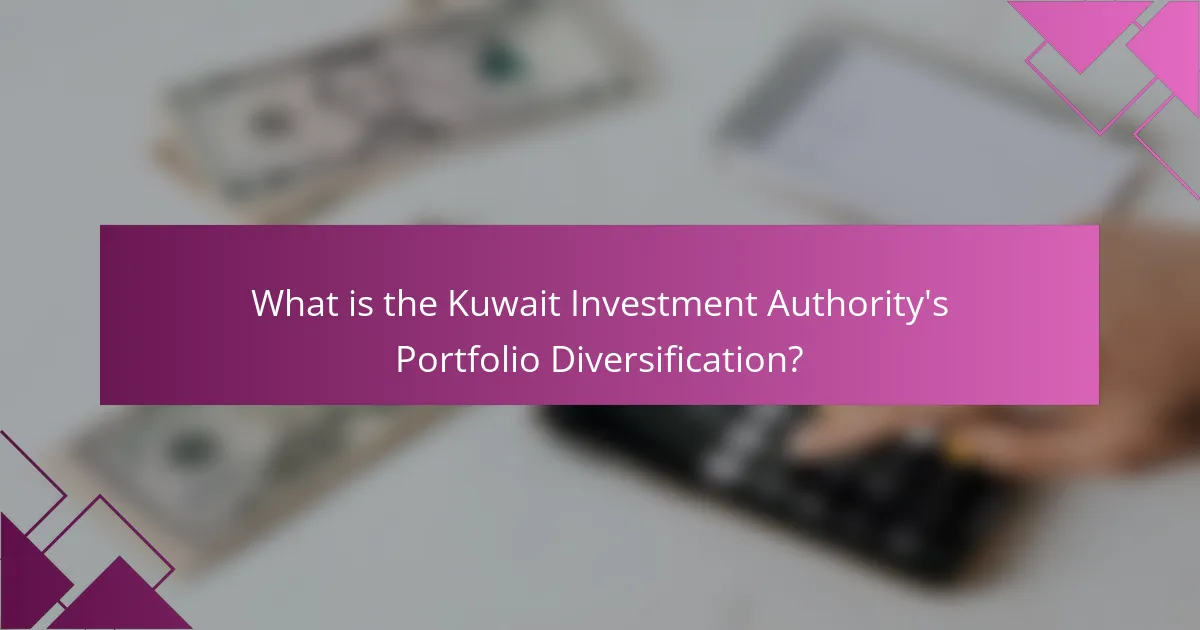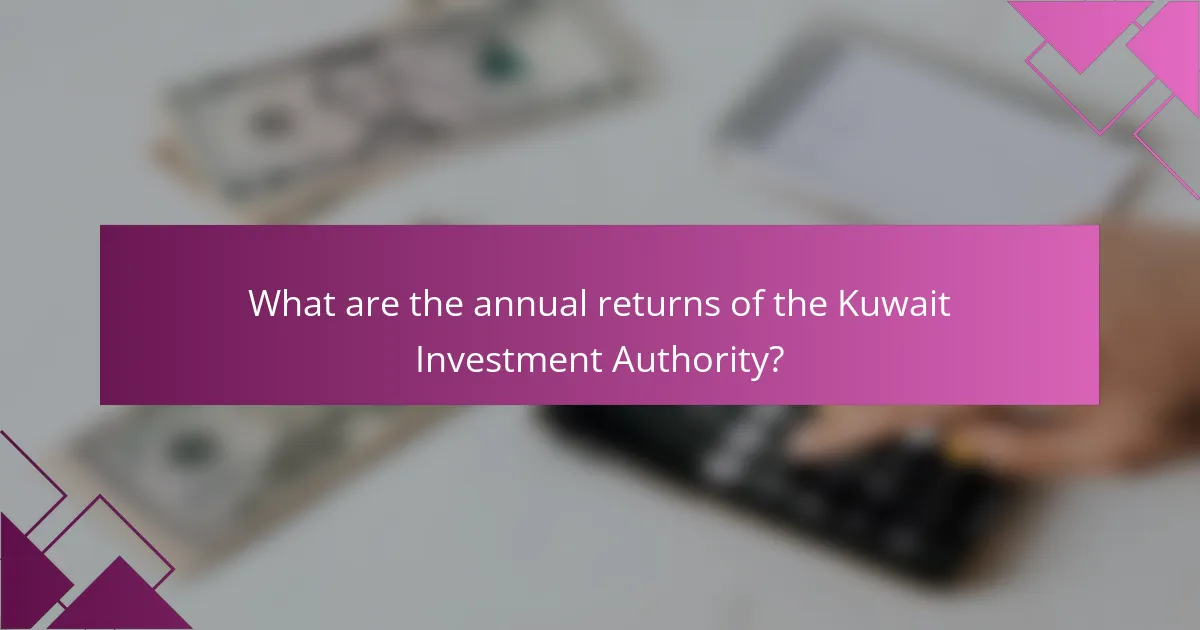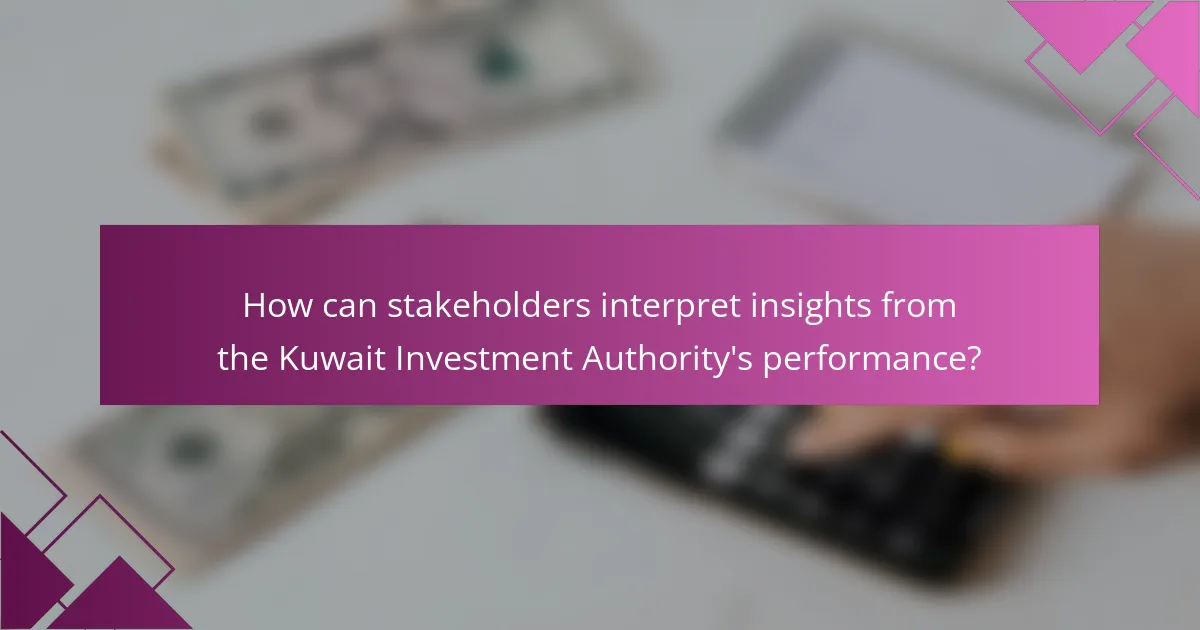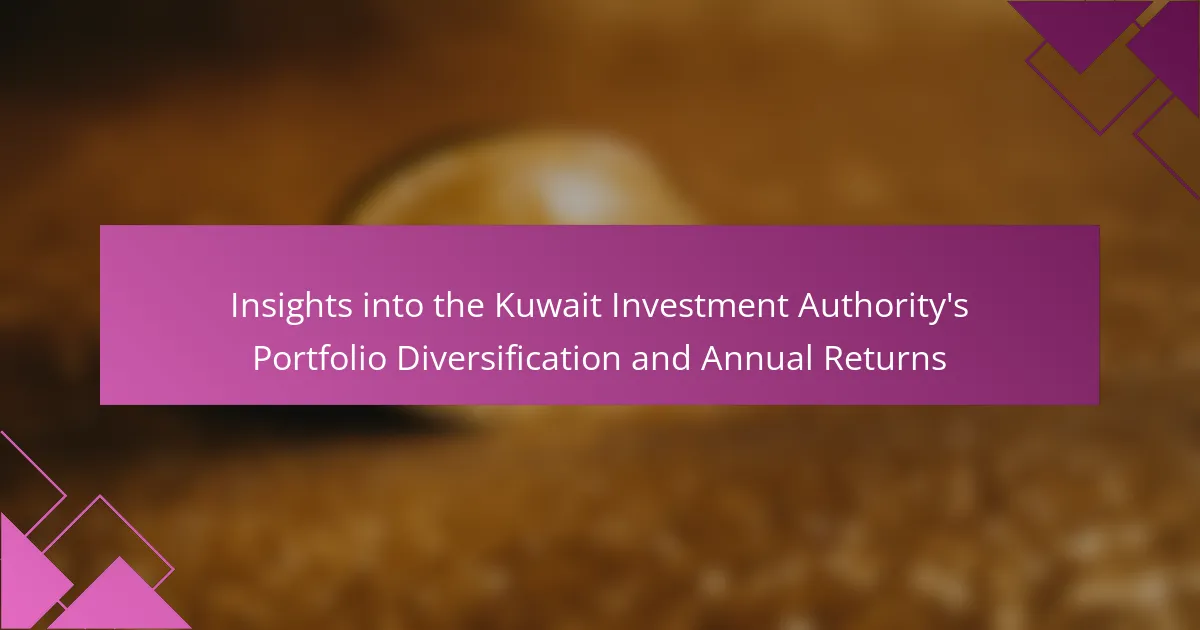
What is the Kuwait Investment Authority’s Portfolio Diversification?
The Kuwait Investment Authority’s portfolio diversification involves a strategic allocation of assets across various sectors and geographies. This diversification aims to mitigate risks and enhance returns. The authority invests in equities, fixed income, real estate, and alternative investments. Its global investment strategy includes markets in North America, Europe, and Asia. The diversified portfolio helps in balancing performance amid market fluctuations. Historical data shows that this approach has contributed to stable long-term growth. The Kuwait Investment Authority is one of the largest sovereign wealth funds globally, managing assets exceeding $700 billion.
How does the Kuwait Investment Authority approach portfolio diversification?
The Kuwait Investment Authority approaches portfolio diversification by investing across various asset classes and geographic regions. It allocates funds to equities, fixed income securities, real estate, and alternative investments. This strategy aims to reduce risk and enhance returns. The authority emphasizes long-term growth while maintaining liquidity. Historical performance shows that diversified portfolios mitigate volatility. The Kuwait Investment Authority’s diversification strategy aligns with global best practices in institutional investing.
What are the key components of the Kuwait Investment Authority’s portfolio?
The key components of the Kuwait Investment Authority’s portfolio include equities, fixed income, real estate, and alternative investments. The equities segment consists of investments in global stock markets. Fixed income investments focus on government and corporate bonds. Real estate holdings encompass both domestic and international properties. Alternative investments cover private equity and hedge funds. The portfolio aims for diversification to reduce risk and enhance returns. The Kuwait Investment Authority manages assets exceeding $700 billion, emphasizing a balanced investment strategy.
How does asset allocation influence the Authority’s diversification strategy?
Asset allocation significantly influences the Authority’s diversification strategy by determining the distribution of investments across various asset classes. This distribution helps mitigate risk and enhance potential returns. By allocating assets among equities, fixed income, real estate, and alternative investments, the Authority can reduce exposure to market volatility. Historical data shows that a well-balanced asset allocation can lead to more stable annual returns. For instance, during economic downturns, certain asset classes may perform better than others, providing a buffer against losses. This strategic approach allows the Authority to align its investment goals with market conditions and risk tolerance.
What are the benefits of portfolio diversification for the Kuwait Investment Authority?
Portfolio diversification for the Kuwait Investment Authority enhances risk management and improves potential returns. It allows the authority to spread investments across various asset classes, reducing exposure to any single investment’s volatility. This strategy helps mitigate losses during market downturns. Studies show that diversified portfolios often outperform concentrated investments over time. Additionally, diversification enables access to different markets and sectors, increasing opportunities for profit. The Kuwait Investment Authority can better withstand economic fluctuations by balancing its portfolio. This approach aligns with global best practices in institutional investing.
How does diversification mitigate risks for the Authority?
Diversification mitigates risks for the Authority by spreading investments across various asset classes. This strategy reduces exposure to any single investment’s poor performance. When one asset underperforms, others may perform well, balancing overall returns. Historical data shows that diversified portfolios tend to have lower volatility. For instance, a study by the CFA Institute found that diversification can reduce portfolio risk by up to 30%. By holding a mix of equities, bonds, and alternative assets, the Authority can achieve more stable returns. This approach aligns with modern portfolio theory, which emphasizes the importance of diversification in risk management.
What impact does diversification have on long-term returns?
Diversification positively impacts long-term returns by reducing risk and enhancing portfolio stability. When investments are spread across various asset classes, the overall volatility decreases. This strategy allows for potential gains from different sectors, even if some investments underperform. Historical data shows that diversified portfolios often achieve higher average returns over time compared to concentrated ones. For instance, a study by Ibbotson Associates found that a well-diversified portfolio can yield returns that are 1-2% higher annually than non-diversified portfolios. This evidence supports the notion that diversification is crucial for optimizing long-term investment performance.

What are the annual returns of the Kuwait Investment Authority?
The annual returns of the Kuwait Investment Authority (KIA) vary by year. In recent years, the average annual return has been approximately 5% to 8%. For instance, in 2021, KIA reported a return of around 6.2%. Historical performance shows fluctuations due to market conditions. KIA’s diversified portfolio contributes to these returns. The portfolio includes equities, fixed income, and real estate investments. This diversification strategy helps mitigate risks and enhance overall returns. The returns are also influenced by global economic trends and investment strategies.
How are annual returns measured for the Kuwait Investment Authority?
Annual returns for the Kuwait Investment Authority are measured using a combination of absolute and relative performance metrics. The authority calculates the total return on investments, which includes capital gains and income generated from assets. This total return is then compared to relevant benchmarks to assess performance. Specific benchmarks may include indices that reflect the global market or specific sectors. The Kuwait Investment Authority also considers risk-adjusted returns to evaluate performance relative to the level of risk taken. This comprehensive approach ensures that the authority accurately measures its investment effectiveness over time.
What metrics are used to evaluate the Authority’s performance?
The metrics used to evaluate the Authority’s performance include total return on investment, risk-adjusted return, and benchmark comparisons. Total return on investment measures the overall profitability of the Authority’s portfolio. Risk-adjusted return assesses performance relative to the level of risk taken. Benchmark comparisons evaluate the Authority’s performance against relevant market indices. These metrics provide a comprehensive view of the Authority’s effectiveness in achieving its financial goals.
How do annual returns compare to industry benchmarks?
Annual returns typically vary in comparison to industry benchmarks. The Kuwait Investment Authority’s annual returns are assessed against established benchmarks like the MSCI World Index. In recent years, the Authority’s returns have outperformed some benchmarks, indicating effective portfolio management. For instance, in 2022, the Authority reported a return of 8%, while the MSCI World Index returned 5%. This performance suggests a strategic advantage in asset allocation. Regular comparison to benchmarks helps in evaluating investment effectiveness.
What factors influence the annual returns of the Kuwait Investment Authority?
The annual returns of the Kuwait Investment Authority are influenced by several key factors. Market performance plays a crucial role, as fluctuations in global stock markets directly impact investment valuations. Economic conditions, both domestically and internationally, affect the overall investment climate. Interest rates are another significant factor; higher rates can lead to lower bond prices, impacting returns. Currency fluctuations also influence returns, particularly given the Authority’s international investments. Additionally, geopolitical stability in the region can affect investor confidence and market performance. Lastly, the diversification strategy employed by the Authority helps mitigate risks and enhance returns across various asset classes. These factors collectively shape the annual financial outcomes for the Kuwait Investment Authority.
How do global market trends affect the Authority’s returns?
Global market trends significantly affect the Authority’s returns. Changes in economic conditions, such as inflation rates and interest rates, influence investment performance. For instance, a rising interest rate can lead to lower bond prices, impacting returns negatively. Conversely, a strong global economy typically boosts equity markets, enhancing returns on stock investments. Additionally, currency fluctuations can alter the value of international investments. For example, a stronger Kuwaiti Dinar can reduce returns from foreign assets when converted back to local currency. Historical data shows that during economic downturns, the Authority’s returns may decline due to reduced market activity and lower asset valuations. Thus, the Authority’s investment strategy must adapt to these global trends to optimize returns.
What role do geopolitical factors play in annual performance?
Geopolitical factors significantly influence annual performance by affecting market stability and investment risks. Political events, such as elections or conflicts, can lead to volatility in financial markets. For instance, instability in oil-producing regions can impact global oil prices, affecting returns for investors like the Kuwait Investment Authority. Economic sanctions imposed on countries can also disrupt trade and investment flows, leading to decreased performance. Additionally, shifts in international relations can alter investment strategies, as entities reassess risk exposure. Historical examples include the 2008 financial crisis, where geopolitical tensions exacerbated market downturns. Thus, understanding these factors is crucial for predicting annual performance outcomes.

How can stakeholders interpret insights from the Kuwait Investment Authority’s performance?
Stakeholders can interpret insights from the Kuwait Investment Authority’s performance by analyzing key financial metrics and portfolio diversification strategies. These insights reveal how effectively the Authority manages its investments across various sectors. For instance, stakeholders should assess annual returns to gauge overall performance. A consistent increase in returns over the years indicates successful investment strategies. Additionally, examining the diversification of the portfolio helps stakeholders understand risk management practices. A well-diversified portfolio typically reduces exposure to market volatility. Stakeholders can also look at sector allocations to identify growth opportunities or potential risks. Historical performance data provides context for future expectations. By integrating these analyses, stakeholders can make informed decisions regarding their engagement with the Kuwait Investment Authority.
What lessons can be learned from the Authority’s portfolio diversification strategies?
The Authority’s portfolio diversification strategies teach the importance of risk management. Diversification reduces exposure to any single asset class. It spreads investments across various sectors, enhancing stability. This strategy allows for potential growth even in market downturns. Historical data shows that diversified portfolios tend to yield consistent returns. For instance, the Kuwait Investment Authority has maintained solid annual returns through strategic asset allocation. This approach highlights the necessity of adapting to market conditions. Overall, effective diversification can lead to long-term financial resilience.
How can other investors apply these strategies to their portfolios?
Investors can apply the Kuwait Investment Authority’s strategies by diversifying their asset allocation. They should consider a mix of equities, fixed income, and alternative investments. This approach helps mitigate risk while optimizing returns. Additionally, investors can analyze market trends and economic indicators to inform their decisions. Implementing a long-term investment horizon is crucial, as it aligns with the Authority’s strategy of sustainable growth. Regularly reviewing and rebalancing the portfolio ensures alignment with investment goals. Historical performance data shows that diversified portfolios tend to outperform concentrated ones over time.
What best practices can be derived from the Authority’s annual returns?
Best practices derived from the Authority’s annual returns include maintaining a diversified investment portfolio. Diversification reduces risk and enhances potential returns. Regularly reviewing asset allocation helps optimize performance. Implementing a long-term investment strategy ensures stability during market fluctuations. Monitoring economic indicators can inform timely adjustments to the portfolio. Historical performance analysis aids in identifying successful investment trends. Transparency in reporting fosters stakeholder trust and accountability. These practices are supported by the Authority’s consistent track record of positive returns over the years.
What future trends should stakeholders watch regarding the Kuwait Investment Authority?
Stakeholders should watch for increased diversification in the Kuwait Investment Authority’s portfolio. This trend is driven by a shift towards alternative investments. The authority is likely to explore sectors like technology and renewable energy. Additionally, there may be a focus on sustainable investing practices. Global economic shifts could influence investment strategies. Stakeholders should also monitor geopolitical risks affecting investment decisions. Historical data indicates that diversification has previously mitigated risks during market volatility. The Kuwait Investment Authority’s commitment to innovation may lead to new investment opportunities.
How might changing economic conditions impact future diversification efforts?
Changing economic conditions can significantly influence future diversification efforts. Economic shifts can alter market dynamics and asset valuations. For instance, during a recession, investments in certain sectors may underperform. This can prompt entities like the Kuwait Investment Authority to reassess their asset allocation strategies.
Data from past economic downturns shows that diversified portfolios often mitigate risks. According to a study by Vanguard, diversification can reduce volatility by 30% during market fluctuations. Therefore, adapting to economic changes allows for better risk management and potential returns.
In summary, changing economic conditions drive the need for strategic diversification adjustments to optimize portfolio performance.
What innovations in investment strategy could affect the Authority’s returns?
Innovations in investment strategy that could affect the Authority’s returns include the integration of artificial intelligence for predictive analytics. AI can analyze vast datasets to identify market trends and investment opportunities. Additionally, the adoption of sustainable and responsible investing strategies is gaining traction. These strategies focus on environmental, social, and governance (ESG) factors, which can enhance long-term returns. Blockchain technology is also emerging as a tool for improving transparency and reducing transaction costs in investments. Furthermore, the use of alternative assets, such as cryptocurrencies and private equity, can provide diversification and potentially higher returns. Historical data shows that portfolios incorporating innovative strategies often outperform traditional investment approaches. For instance, research indicates that ESG-focused funds have consistently delivered competitive returns compared to traditional funds.
What practical tips can stakeholders consider when analyzing the Kuwait Investment Authority’s performance?
Stakeholders should focus on several practical tips when analyzing the Kuwait Investment Authority’s performance. First, examine the annual reports for detailed financial data. These reports provide insights into investment strategies and outcomes. Second, assess the portfolio diversification across various asset classes. A well-diversified portfolio can mitigate risks and enhance returns. Third, track historical performance metrics against benchmarks. This comparison helps gauge the effectiveness of the Authority’s strategies. Fourth, consider macroeconomic factors that may impact investment performance. Economic conditions can significantly influence returns. Fifth, review the governance structure of the Authority. Strong governance can lead to better decision-making and accountability. Finally, engage with industry analysis and expert opinions. External insights can provide additional context to the Authority’s performance metrics.
The Kuwait Investment Authority (KIA) is a prominent sovereign wealth fund managing over $700 billion in assets. This article provides an in-depth analysis of KIA’s portfolio diversification strategy, which includes investments in equities, fixed income, real estate, and alternative assets across various global markets. Key components such as asset allocation, risk management, and the influence of economic and geopolitical factors on annual returns are examined. Additionally, the article highlights the benefits of diversification for long-term returns and offers practical insights for stakeholders to interpret performance metrics effectively.
